Fight, Flight, or Freeze Releasing Organizational Trauma @mattstratton
Slide 1

Slide 2

Content Warning: Discussion of trauma and posttraumatic stress @mattstratton
Slide 3

I am a trauma survivor I am not a mental health professional @mattstratton
Slide 4

A zebra at rest with no threat of predators, for instance, will be operating within the “rest and digest” functions of the parasympathetic nervous system. When chased by a lion, drastic physiological changes with the activation of the fight-or-flight response of the sympathetic nervous system : heart rate increases, breathing increases, large amounts of stress hormones like cortisol and adrenaline are released into the bloodstream, pupils dilate, blood pressure increases and any non-essential functions like digestion stop. The zebra’s nervous system prepares it to run for its life. If the zebra is caught, the nervous system is overwhelmed, and has no further solutions - this is the freeze response. This point is what we consider trauma. Zebra that survives the encounter literally “shakes it off” and returns to a resting state.
Slide 5

Humans are not zebras @mattstratton The autonomic nervous system is common to all mammals. However, humans have a pre-frontal cortex, which zebras do not. This is usually an advantage, but the disadvantage is that we mentally replay traumatic scenarios, which activates our sympathetic nervous system exactly like the real threat would. The prefrontal cortex is where executive function happens - I.e., difference between good and bad, same and different, understanding consequences, etc
Slide 6

“Animals in the wild are not traumatized by routine threats to their lives, while humans, on the other hand, are readily overwhelmed and often subject to the traumatic symptoms of hyper arousal, shutdown and dysregulation.” – Dr. Peter Levine @mattstratton
Slide 7

The window of tolerance refers to a zone of “emotional arousal that is optimal for well-being and effective functioning,” (Siegel, 1999) Parasympathetic - rest and digest, conserves energy, etc Sympathetic - fight or flight response
Slide 8

Hyperarousal is similar to the “fight or flight” response. hypoarousal is similar to the “freeze” response
Slide 9

Nuanced @mattstratton Trauma isn’t simple
Slide 10
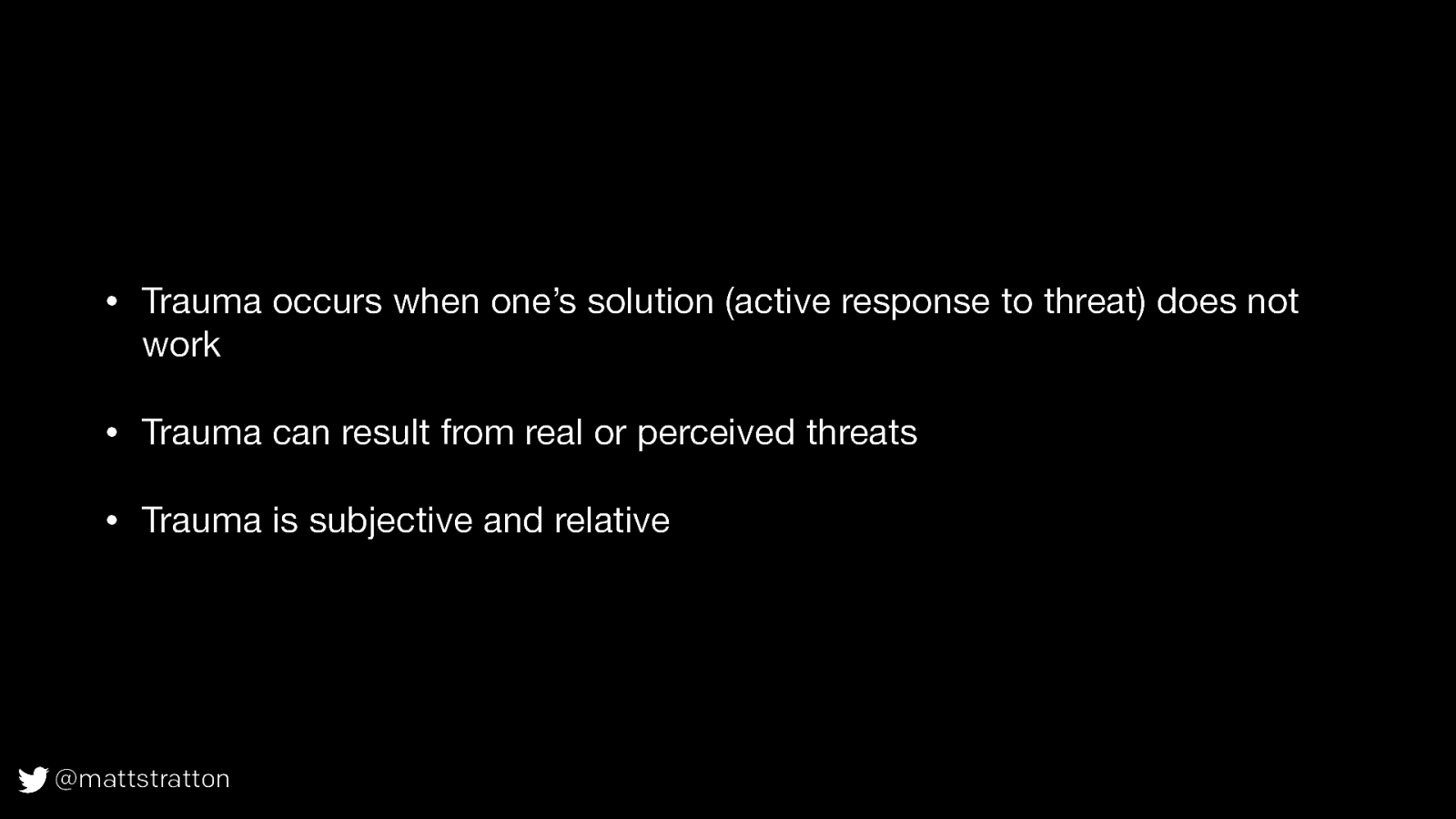
• Trauma occurs when one’s solution (active response to threat) does not work • Trauma can result from real or perceived threats • Trauma is subjective and relative @mattstratton
The nervous system has been overwhelmed Nervous system activation is the same for real and imagined threats What I perceive as overwhelming, or my capacity for solution, may be different than what you perceive as overwhelming
Slide 11

How does this apply to an organization? @mattstratton
Slide 12
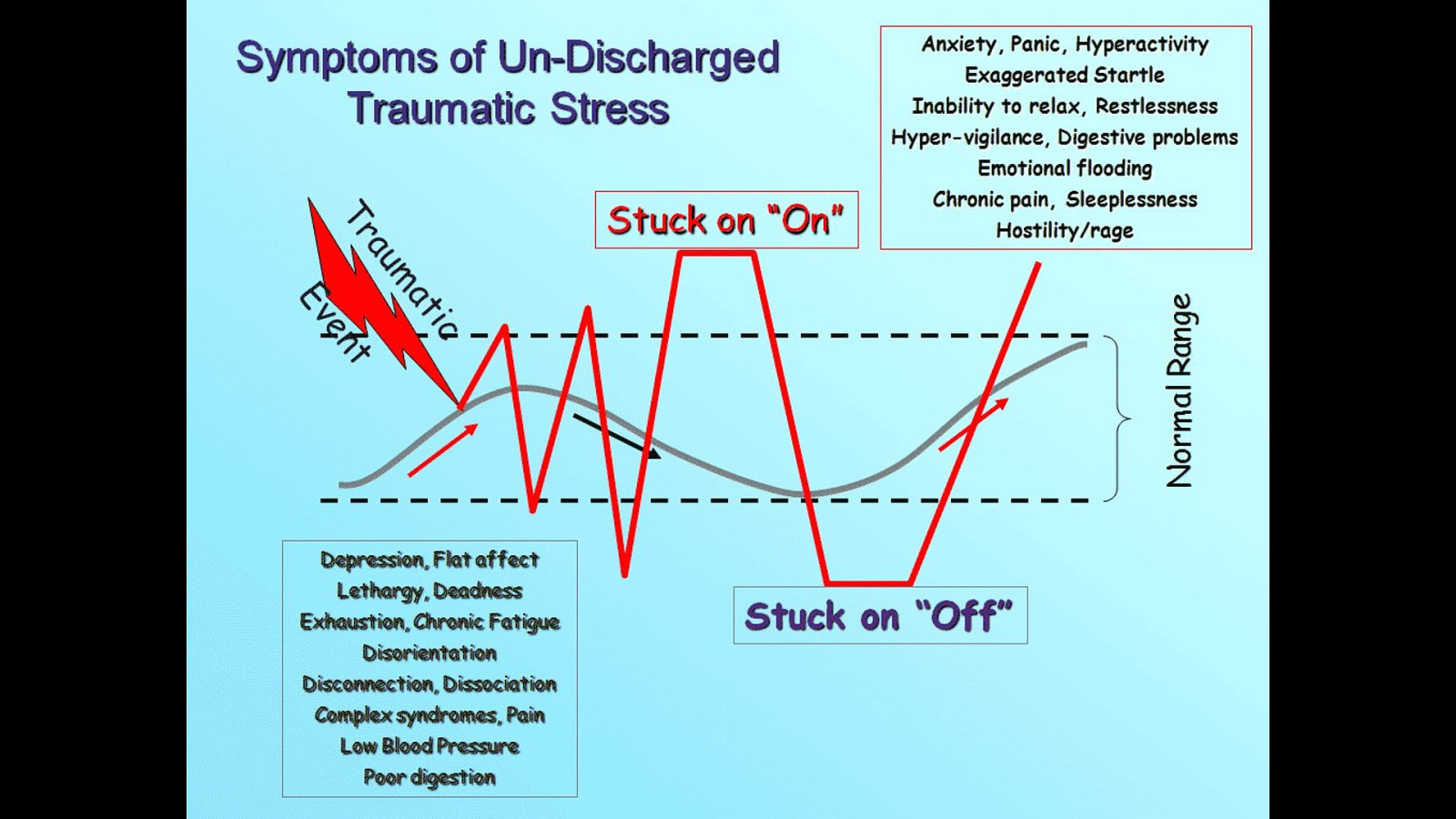
Let’s look at a deregulated nervous system again, and see how it might apply to an organization when a traumatic event occurs (an outage, etc)
Slide 13
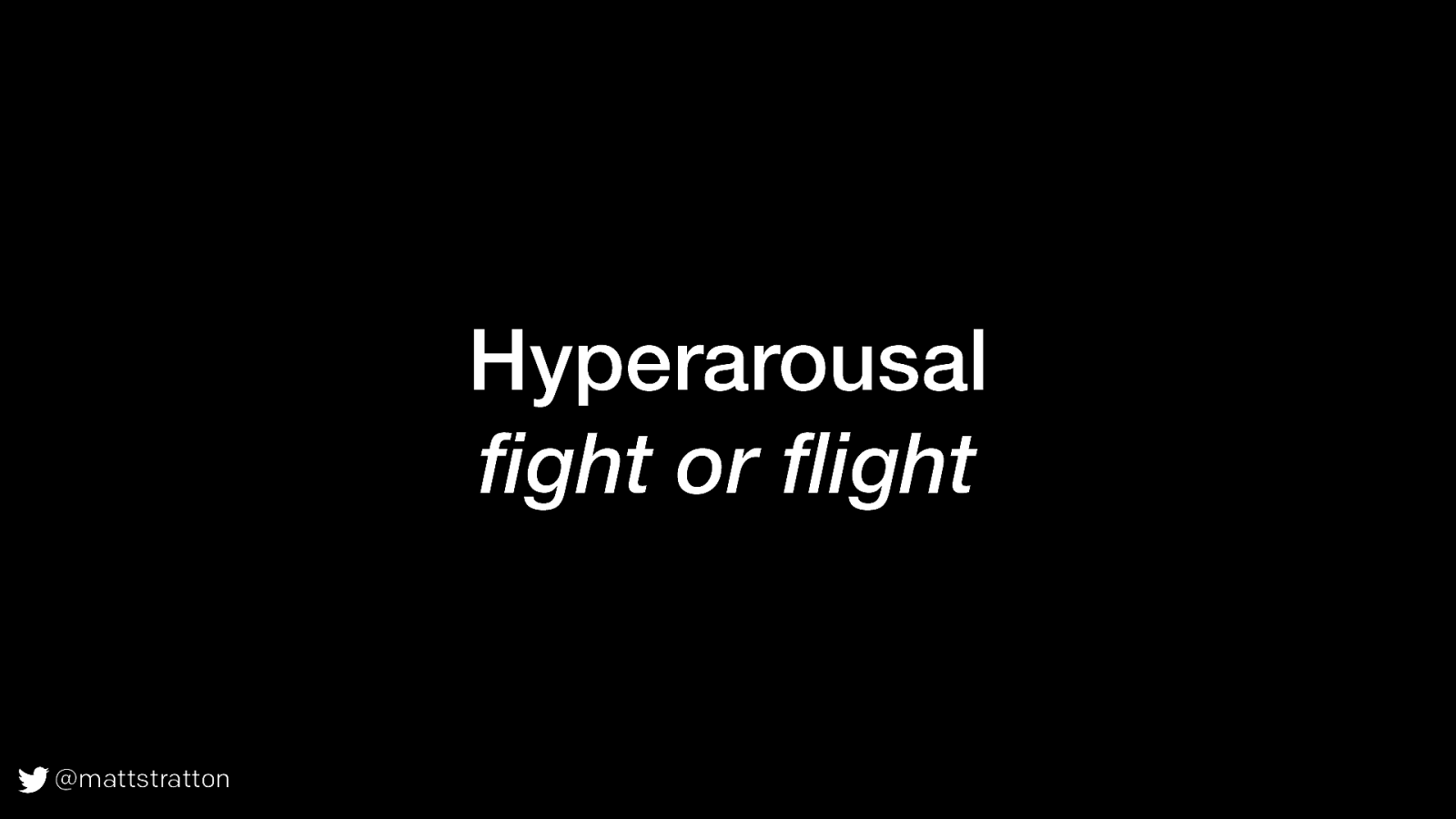
Hyperarousal fight or flight @mattstratton Hyperaroused organizations will display effects of “constant vigilance” and be hyper-aware of threats which take energy away from moving forward. They are “stuck on on”. Often times this is reflected in how leadership approaches outages and issues. Wartime metaphors, etc. Production support teams.
Slide 14

Hypoarousal freeze @mattstratton Hypoaroused organizations are unable to proceed or innovate. They are “stuck on off”
Slide 15

Inappropriate response @mattstratton The signal may seem similar, but it’s not exactly the same. We look for pattern recognition, because the signals seem the same as previous examples, but the complexity makes this inappropriate.
Slide 16

Consider removing shoes at the TSA. December 22, 2001.Richard Reid tries to ignite explosives hidden in his shoes on a flight from Paris to Miami. As a result, TSA begins randomly searching people’s shoes. In 2006, the TSA mandates that all passengers must remove their shoes going through security.
Slide 17

@mattstratton We need to learn to stop jumping on the first root cause. And look - more zebras.
Slide 18

Identify your organization’s window of tolerance @mattstratton What can we do to understand our window of tolerance as an org? How can we identify when we are deregulated?
Slide 19

“Resilient organizations are not traumatized by routine threats to their mission or buisness. Non-resilient organizations are readily overwhelmed and often subject to the symptoms of overreaction, shutdown and lack of regulated effort.” – Matty Stratton (Not a doctor) @mattstratton
Slide 20

Regulate @mattstratton No, this is not a Warren G reference. How do humans and organizations take a deregulated state and become regulated?
Slide 21

One of the treatments for post-traumatic stress is Eye Movement Desensitization and Reprocessing (EMDR), in which the patient’s difficult memories are offset with a positive association that is reinforced through external stimuli.
Slide 22

Organizational EMDR @mattstratton Obviously, we can’t do the exact same thing. But what are some things that we can do, to help achieve the same result?
Slide 23

Game days @mattstratton We want to make an association with outages and issues with a safe place. Game days can help do this, but they have to be done properly. Keep them low stress and safe - the point isn’t to practice under pressure, but to associate response with a safe environment.
Slide 24

When exploring in a game day, you need to have guidance. It’s like meditation. With some kinds of trauma, meditation is helpful. But the problem is when people go into their inner landscape and they’re not prepared and they’re not guided, sooner or later they encounter the trauma, and then what do they do? They could be overwhelmed with it, or they find a way to go away from the trauma. Similarly, if we don’t have plans in place for our game day, we are going to get wound around the axle. Also, in meditation for trauma, we can get what Levine calls “bliss bypass”. It’s a way of avoiding the trauma - so if our game isn’t following our usual rules, we made it “too” safe.
Slide 25

Planned failure injection @mattstratton If you do planned failure injection in a gameday, run them like a real incident. Failure Fridays at Pagerduty for example. We follow full Incident Command processes. This causes an organizational association of a safe place for incidents.
Slide 26

This is also why you run all incidents at the initial severity. Even if you start them and realize they weren’t an incident, or a sev 1, or whatever, run them to their full course.
Slide 27

Process failure @mattstratton Blameless is just the beginning here. We need to process the failure/outage through all the information that we have, and the processing needs to have a conclusion. Otherwise it is unprocessed trauma. There is a misconception that to process trauma is to “get it all out”. We need to integrate our experiences into a coherent whole. This includes telling our stories as well as changing our autonomic nervous systems, which in the case of an organization has to do with how we respond to outages and incidents.
Slide 28

It’s essential to tell our stories. That’s how we process them. This happens for individuals but also for your larger organization. Write-only postmortems don’t help anyone
Slide 29

A word about somatic experiencing @mattstratton In top down therapy, it starts with the emotions. Why do you feel the way you do. This is very similar to looking for a root cause first. In somatic experiencing, the body is worked with first, to enable a titrated approach to the emotions. Similarly, during an incident you are working to restore service prior to determining cause. And it’s important to look at the whole system when processing it, not starting with the surface “emotions” which are the symptoms of the outage.
Slide 30

Cognitive distortions @mattstratton Cognitive distortions are exactly what the name implies: distortions in our cognition. They are perspectives with bias. They are irrational thoughts and beliefs that we unknowingly reinforce over time. These patterns and systems of thought are often subtle – it’s difficult to recognize them when they are a regular feature of your day-to-day thoughts. There are as many as 16 generally accepted cognitive distortions; we’re only going to touch on a few that might be causing issues for you in your organization.
Slide 31

Polarized thinking @mattstratton Also known as “all or nothing” thinking. This is seeing everything in extremes. It’s either perfection or total failure. Remember that our systems are always in some state of failure; we don’t have perfection.
Slide 32

Overgeneralization @mattstratton Here we take a single instance and generalize it to an overall pattern; in a personal level, this could be “oh no, I got a C on this test, so I’m stupid and a failure”. In an organization, it can be “we had a sev 1 incident on this particular service, so it’s unstable”. Combined with another distorition, the Mental Filter, this can manifest as only seeing the negative and eliminating all positives about a situation, a person, or a system
Slide 33

Fortune telling @mattstratton We do this one a LOT in IT - we feel like we have data that will be predictive (hello machine learning!) so if we only know enough, we can predict the future. Yes, we can start to get ideas on what is likely to happen, but guess what - our systems are complex. We need to be able to understand that our predictions are not fact, but actual just one of several positive outcomes
Slide 34
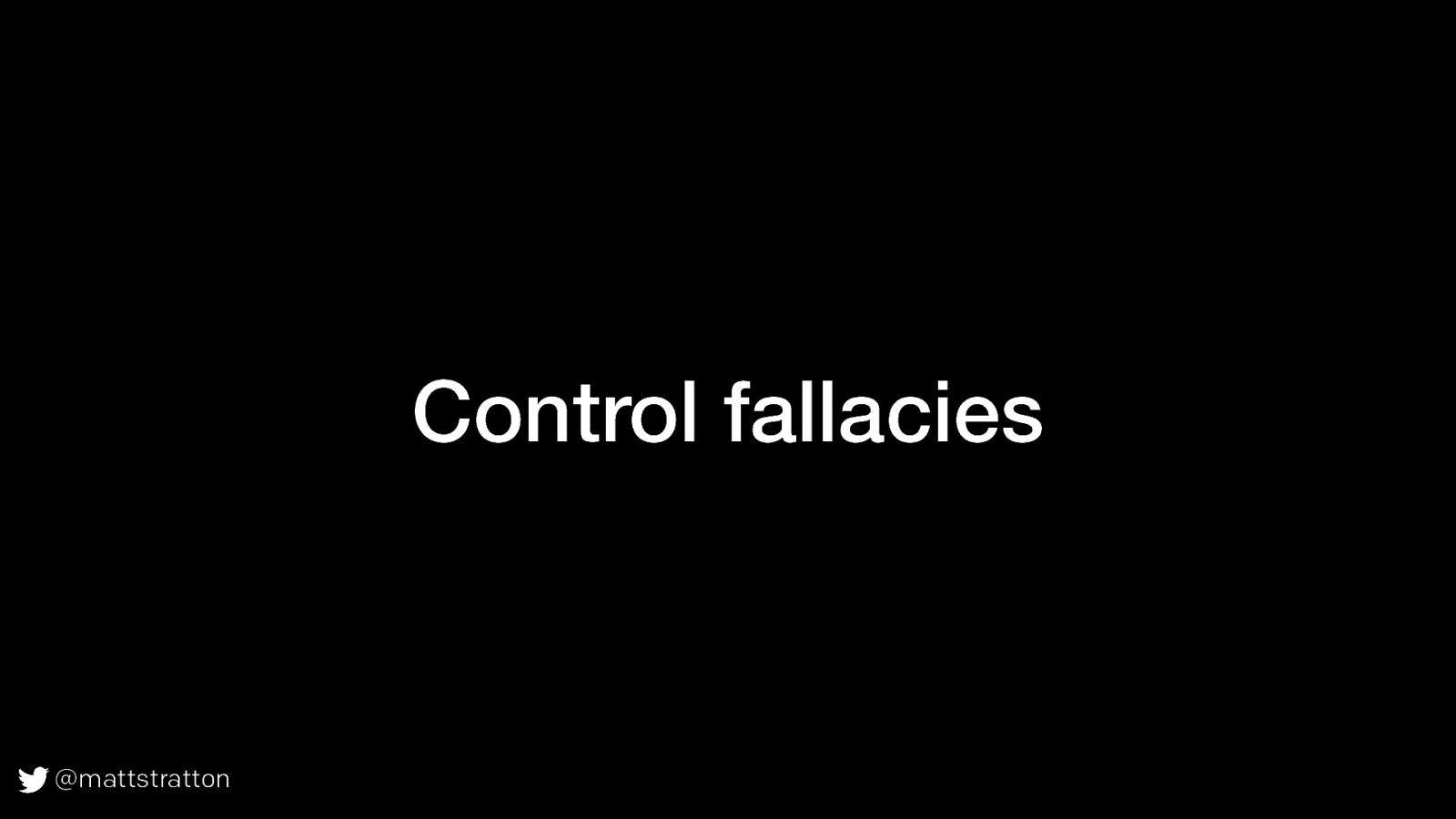
Control fallacies @mattstratton A control fallacy manifests as one of two beliefs: (1) that we have no control over our lives and are helpless victims of fate, or (2) that we are in complete control of ourselves and our surroundings, giving us responsibility for the feelings of those around us. Both beliefs are damaging, and both are equally inaccurate. No one is in complete control of what happens to them, and no one has absolutely no control over their situation. Even in extreme situations where an individual seemingly has no choices in what they do, where they go, or what they say, they still have a certain amount of control over how they approach their situation mentally.
Slide 35

Self-care @mattstratton
Slide 36

Why does self-care matter? Burnout is a real thing.
Slide 37

Context switch @mattstratton Create a ritual around going on and off call. This helps your body understand that things are changing. For example - whenever I take out my contacts, I get sleepy. Likewise, when I put them in, I feel awake. This is from decades of experience of putting contacts in my eyes in the morning, and taking them out before bed. My body has expectations.
Slide 38

Allocate mental bandwidth @mattstratton If you are on-call, allow this to be your #1 priority. Don’t try to deliver high-priority projects at the same time. Having a good relationship with your manager is key for this - work with her to help her understand where you are coming from with this, and help set expectations.
Slide 39

Treat yourself @mattstratton Have an awareness that on-call is stressful. Take some extra time to “treat” yourself during these times to help counter the stress.
Slide 40

“The weeks that I am on-call, I schedule wine with my girlfriends or plan to go out for my favorite dinner…this can be a really rough week, but I have something to look forward to” –Ana Medina, Gremlin @mattstratton
Slide 41

Stay healthy @mattstratton It’s very tempting and common to fill ourselves with sugar and caffeine while on-call…however, this is detrimental. Eat healthy! Stay hydrated and drink a lot of water. There is a physical effort to being on-call…it’s like being an elite athlete. Keep healthy. Take care of your body and your brain.
Slide 42

Tips from the twittererverse @mattstratton As always, I go to Twitter to get some suggestions.
Slide 43

Slide 44

Slide 45

Slide 46

Slide 47

And if all else fails… @mattstratton
Slide 48

Slide 49
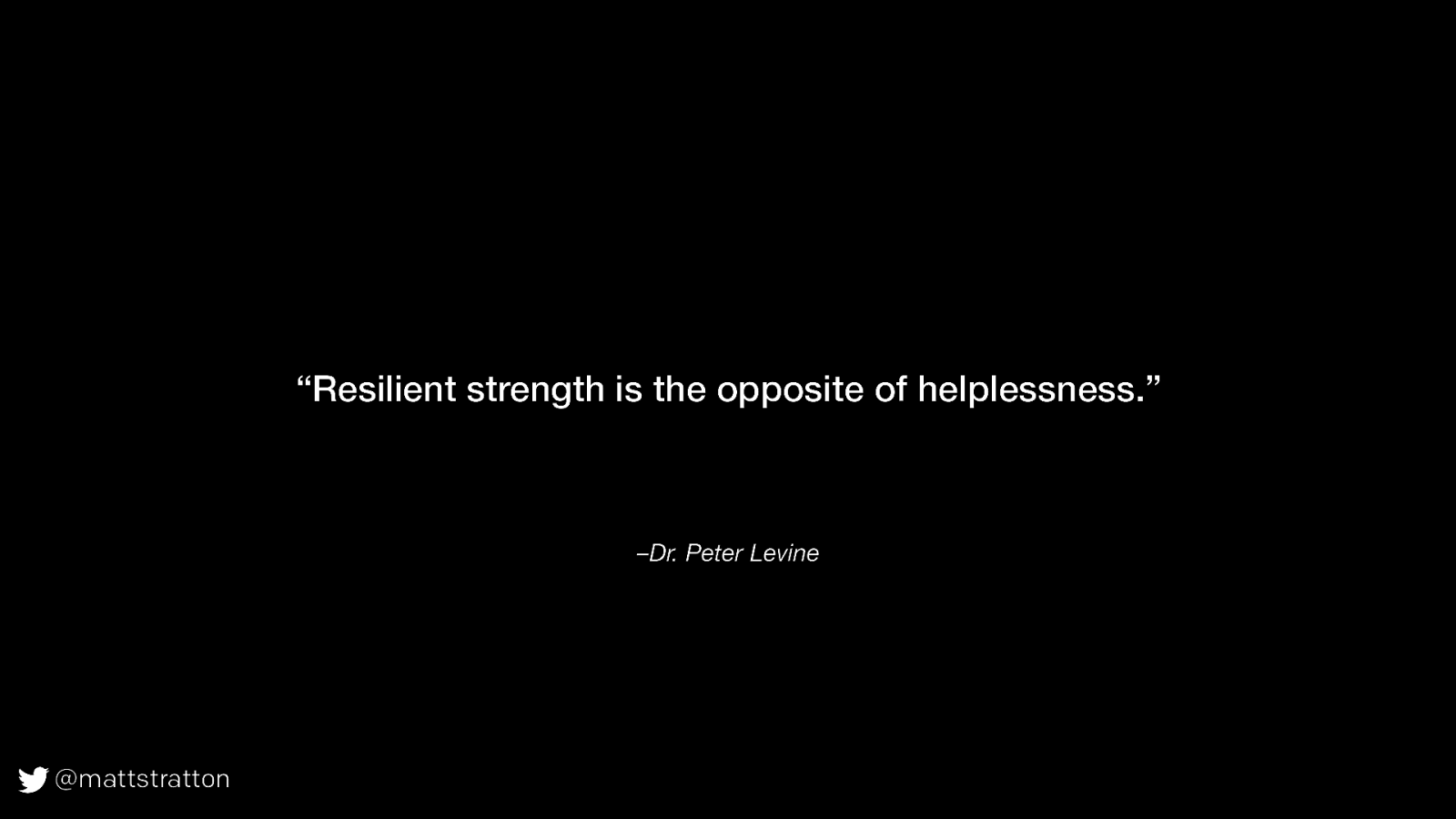
“Resilient strength is the opposite of helplessness.” –Dr. Peter Levine @mattstratton Being resilient means that we don’t see things from the perspective of things that happen TO us. It is a matter of what can we do going forward. A culture of blame creates a culture of helplessness.
Slide 50

https://speaking.mattstratton.com @mattstratton This deck, as well as supporting links and resources, will be available at this URL. Thank you!